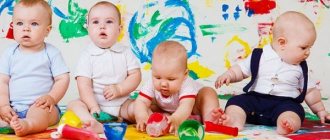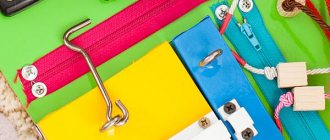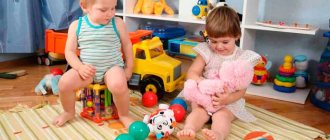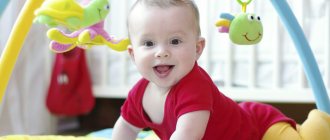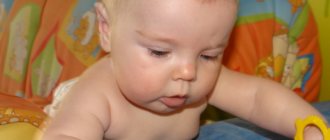The appearance of a child in a family is associated with a number of new responsibilities that fall on the shoulders of the parents. It is in the first year of life that the baby is completely helpless, and along with feeding, bathing and walking, parents must deal with early development and the choice of educational games. What toys does the baby need, what sounds to teach him, what cartoons to include - we will try to answer these and other questions further.
When to start classes
The ideal time for developmental activities with a child in the first months of life is when the child is full, happy and does not want to sleep
.
A newborn, as a rule, is either in a state of hunger or asleep. In addition, the first month is when the family adapts to the new mode of existence, the mother learns to care for and understand her child. Therefore, parents can usually start educational games and activities from the second month of the baby’s life
.
The afternoon is a good time for developmental activities. You will find a complete list of educational activities and toys for each age in our “Guide ...”.
Games for children from six months old
When a child turns six months old, he becomes interested in the world around him and becomes more active. Now he is interested in games related to movement and cognition.
- To the music, the child is already imitating the dance with his hands, repeating sounds, and cooing.
- Children happily play with a ball: a ball with a bell develops hearing, a ball with pimples develops motor skills. It is also worth taking an inflatable ball, putting the child on it with his stomach and rocking it, holding the baby well. Not only is it fun, but it's also good for your back.
- A child will enjoy playing with water: pour water into a deep plate, dip the baby’s fingers in it, and let him feel the contents of the container.
- Play with soft books, show your child mom, dad and other people he knows in the photo.
- Call the baby in turn with dad or grandma, and then ask: “Who is calling Vanechka?” The baby should turn towards the adult who called him.
- Allow your child to touch all the objects he likes, simultaneously pronouncing their names and showing their purpose. Use the remote control to turn on the TV, call from your mobile phone and let the baby listen to the voice of dad or grandma, turn on and off the lights. The sooner the baby learns everything around him, the sooner he will stop grabbing objects that are not his toys.
Educational games for the little ones are selected depending on what interests the child at a particular stage of life. When your child is 4-5 months old, you will already know what kind of toys and games attract him, so you can easily select a good program.
Educational toys
Toys for children in the first months need to be very simple - light, sounding, interesting texture, made from natural materials.
One of my favorite sounding toys is a small bell.
(for example, Valdai). Children are ready to listen to its ringing for a long time and follow it with their eyes.
To teach your baby to use his hands, a light rattle with a ring is suitable, which the child can pick up in his hand. Gradually, he will begin to associate the rustling of the rattle with the movements of his hand. Playing with a massage ball
helps open the palm.
Beautiful Russian folk rattle made of birch bark - sherkunok
.
By placing it in the baby's hand, we develop the correct grip with abduction of the thumb. The quiet rustling sound develops hearing and calms the baby. Natural material has an interesting heterogeneous texture
. Birch bark has its own pleasant smell and taste, different from the same primitive taste and smell of plastic toys.
Experts in Waldorf pedagogy call for surrounding the baby only with “real” objects
, not deceiving the senses.
Thus, a plastic cube with a wood pattern deceives the child’s senses, not having the properties of real wood (weight, texture, smell, etc.). Therefore, it is recommended to select toys for children from various natural materials
, highly artistic simple shapes (for example, folk craft toys), natural colors, natural sounds (bells, bags of peas, beans, etc.).
Games for children under six months
When a baby turns 2-3 months old, he strives to explore the world around him, and the best toys for children of this age are the objects around them. To keep your child occupied, you should use games recommended by pediatricians.
- To develop speech and hearing, a mother should read poems to her child and sing songs that he will listen to with pleasure. At the sound of his favorite tunes, the baby will rejoice, clench his fists, and look at his mother.
- To play, take 2 dolls that you put on your hands, and then act out a scene for your baby or move the dolls, making simple sounds.
- Just like listening, the baby is very interested in looking at his parents, so don’t forget about the classic game of hide and seek. Just cover your face with your hands, and then show yourself to the baby, saying “peek-a-boo.”
- To develop motor skills, it is worth stretching the child’s hands, running your finger over them, while telling a little rhyme about a magpie-crow or little hares.
- Take a bright toy and tilt it to the sides or make an airplane motion so that the child follows it with his eyes. After 4.5-5 months, the child will want to hold the rattle, so after playing, give it to the child's hand.
- Invite your child to look in the mirror, holding the mirror 2 palms away from the baby.
It is worth remembering that educational games for children should not last longer than 10-15 minutes, and you should play with your child 5-6 times a day. In a short time, the baby will not have time to get tired, will not be capricious and will begin to show more and more interest in the game.
Educational cards
Educational activities with cards train the baby to focus his gaze and accelerate the development of clear vision. And they begin to introduce him to the huge world in which he will live. There is a wide variety of educational activities, ready-made sets of cards with pictures and words. Choose according to your taste, but remember that the child needs harmonious development (mind-soul-body). Do not turn developmental activities into intellectual training. You are raising a person, a friend, an assistant. Pay more attention to developing human qualities
The child has. And let each lesson be imprinted in his soul as the joy of communication and knowledge of the world.
Crawling track - the first exercise machine for a baby
Crawling in the first months is possible thanks to an innate reflex. Place your baby on his stomach on a smooth surface and place your hands under his feet for support. Pushing off from the support and straightening his bent legs, the baby moves forward. This is a useful exercise that improves connections between the right and left hemispheres of the brain. Crawling also helps strengthen the musculoskeletal system and the overall physical development of the child. You can read more about the early crawling method in the works of Ch. Doman (“How to teach your baby to read”, “What to do if your child has brain damage”, “How to make your child physically perfect. From birth to six years”, “Yes, your child is a genius!”)
A track can be used for crawling in the first months of life. If its sides are upholstered with soft material, you can put your baby there to crawl alone instead of a playpen. He will crawl forward, pushing off the walls. First install the track at a slightly angle so that the child can immediately see the results of his efforts and want to move on. You can help your baby by placing your fingers under his heels. Gradually, the child will learn to crawl on a horizontal surface. Early reflex crawling is a bridge to the next essential skill: cross synchronized crawling. (More on crawling...).
How to play with a newborn baby
The apartment in which you live is ordinary and familiar to you, but for your baby it is an amazing, unknown world.
Finding out what it is hanging on the wall and ticking is a fun game. From birth, you can plan in advance the route for your excursion around the apartment, and carry out the walk every day without changing the sequence of points. Here is a mirror hanging, say “hello” to it, show it where you are and where the baby is. Further along the route there is a clock: it hangs on the wall and is ticking. If you only have a wristwatch, then you can put it to the child’s ear, let him listen, hide it under the blanket, and then happily find it.
Absolutely all children love to play with light. Tears dry instantly as soon as the child's hand is on the switch.
For special days when the child is in a bad mood, you need to prepare a magic box. Of course, this is a completely ordinary shoebox, for example, but inside it will be riches, just like in your childhood. Place there a small ball, a container of cream, items that are unnecessary in the house, but quite suitable for exploration by a little person. As soon as Day H arrives, remove the box and give it to your child. He will instantly calm down and will enthusiastically pull out more and more unknown objects.
And I would like to end such a lengthy article with a quote from my beloved Fromm: “Not a single toy, taken separately, will bring the educational benefit that is reported on its packaging. This can only be done by all the toys together. Only together they will help the child spend his time profitably. In addition, the point of toys is not only to develop children's observation, attention and other useful qualities. Toys should still just entertain, and don’t stop them from doing that.”
| Return to list |
Mobile
A well-fed and tired baby can be placed in a crib under the mobile. Watching moving figures develops vision. Various musical mobile toys can be purchased in children's stores, but from the point of view of a child's development, mobiles made independently are the most valuable
. It is not so important whether it is a complex design or just a clothes hanger mounted above the baby’s crib. The main thing is to be able to hang different toys and change them.
The simplest homemade toy is paper. You can use the origami technique by folding cranes, boats, and flowers from multi-colored paper. Or draw simple images on both sides, for example, using images from lullabies, nursery rhymes or songs that you often sing to your child (for example, magpie, parrot, cat, etc.). You can sew simple figures of animals or birds. All toys made from different materials will move differently on the mobile. At the same time, it is enough to attach 2-3 toys to the mobile, changing them after 3-4 days.
Finger games, as well as Russian folk nursery rhymes and jokes
You can begin to develop your child’s speech immediately after being discharged from the hospital.
In this matter it is never too early, it is only too late. A child’s speech is closely related to the development of his hand; experts call this fine motor skills. When we develop fine finger movements, we directly influence the area of the brain that is responsible for the appearance of syllables, and then words and sentences in a child’s speech. While the baby cannot pick up beads or knead plasticine with his fingertips, we must activate the necessary zones ourselves. This is very simple to do, and again in the form of a game! Breastfeed the baby, gently rub, massage the tips of the baby's fingers, rub them. As soon as your baby grows up, you can start playing so-called finger games with him. Our Slavic ancestors played them with children and they are recorded in the children's nursery rhymes that have come down to us: “The White-sided Magpie,” “The Horned Goat,” and “Ladushki.” Here is an example of one, called “Family”, you alternately bend and massage your fingers from the big to the little finger: “This finger is grandfather, this finger is grandmother, this finger is mother, this finger is mother, this is the finger of Veronica (child’s name).” While you were still pregnant, you couldn’t even imagine that you could come up with your own lullabies on the fly and treat your child so tenderly. The love of a mother, the tenderness that the baby evokes in her, is conveyed by folk wisdom embedded in nursery rhymes, jokes and nursery rhymes. In the old days, the baby was nurtured, that is, cherished. The baby woke up, and the mother was already nearby, sitting and saying: “Stretch, stretch, Across the fat one, And in the legs - walkers, And in the arms = grabs, And in the mouth - a talker, And in the head - a mind!”
We stroked the child, straightened his arms and legs, bent and straightened him, after gymnastics you need to wash yourself and not forget about the baby: “Water, water, wash (child’s name) face, So that the eyes sparkle, So that the cheeks blush, So that the mouth laughs, So that it bites tooth!
The baby ate, rested, you can tell him one more poem: In the bright little house “(Girl’s name) grew up, People love her, Everyone loves her.”
And you can read to your son: “Who is good with us? Who is our handsome one? Kolenka (boy's name) is good, Kolenka (boy's name) is handsome.
There will be no harm if you read the poems of Pushkin or your favorite poet of the Silver Age. The main thing is to do it with joy, tenderly and affectionately.
Developmental environment - ideal environment
A harmonious environment contributes to the formation of a healthy, harmonious person. By surrounding a child with harmonious objects that are pleasing to the eye, we form his tastes, likes, and worldview in accordance with our own, and we raise a person who is dear to us.
Let’s not forget that any special “developmental activity” or “unique technique” is just one of the options for stimulating the baby’s brain
, no more or less effective compared to others provided by developmental care (carrying in arms and in a sling, maternal massage, breastfeeding, vestibular gymnastics, planting, etc.).
The best educational activity for a child in the first months of life
- this is to be included in the interesting life of a loved one, full of varied activities. Be there for your children!
Developmental activities for a child over 4 months old
For the development of a child after 4 months, it is necessary to organize space on the floor.
It is better if it is not a playpen, but a rug or mat. The child will not fall off them and will be able to move freely and explore the world. Start thinking about a safe home for your baby before he can crawl.
It is also good to arrange a Montessori corner in the children's room. These are special shelves on which the first toys are neatly placed.
.
There should be few toys, just a few pieces, one of each type. Next to the shelf, prepare a comfortable space for games - a mat with a non-slip surface that is easy to wash. will teach your baby to be in order
from the very beginning .
is important for a crawling child so that he can choose when and what to do.
.
And then mom has additional free time. For the full physical development of a child of the first year, a sports complex is needed at home, preferably with a monkey bars
. You can read more about its use in our “Manual...”.
For a baby who crawls well and is already starting to walk, he needs a slide, it can be part of a sports complex, and a staircase on which he can walk and crawl. You can read more about the experience of organizing a home sports corner for children after one year here. To combat flat feet, there is nothing better than walking barefoot on grass and gravel. Therefore, you should try to go out into nature with your walking baby in the summer.
In our video tutorial “Developmental Baby Care” you can also watch a section dedicated to developmental activities with a child in the first year of life.
The easiest and most effective way to organize developmental activities for a child of the first year of life is to think over an appropriate, interesting and safe environment at home. Every family can do this. Try it!
Intellectual development
It is believed that the level of intelligence is established at a very early age and the degree of its development depends primarily on the efforts of parents. Therefore, it is very important to pay attention to the intellectual development of the baby.
1. Study of geometric shapes:
- from an early age you can start showing your child black and white pictures with geometric shapes;
- teach your child to play with blocks (for example, build a tower), as well as figures moving in a spiral, etc.
2.Study of colors:
- children love to play with glasses or boxes of different sizes;
- Teach your child to build using construction blocks of different colors.
3. Lessons on attentiveness and logic:
- show your child how to play with the pyramid;
- play hide and seek (you can cover your face or your child’s face with your hands/handkerchief/diaper or hide a toy);
- scatter and stack homogeneous objects with the baby;
- assemble simple puzzles;
- Teach your child to play with the sorter and frame inserts.
4. Study of the surrounding world:
- invite your baby to touch objects of different textures;
- catch small toys in the water (you can use a scoop or net);
- roll toys with your child in a box using a string;
- pour water from one container to another;
- teach your child to throw toys into a box/bucket;
- Invite your child to play with sand or snow outside (using a shovel, rake, bucket, molds).

